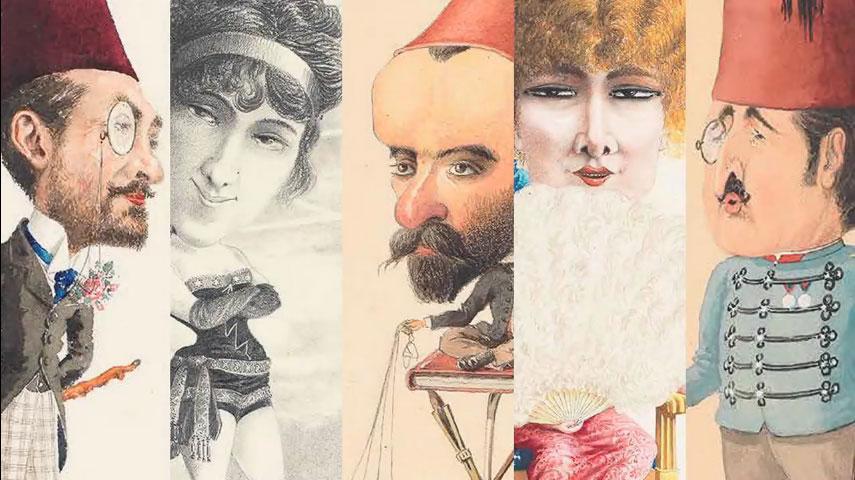
‘Youssouf Bey: The Charged Portraits of Fin-de-Siecle Pera’ edited by Bahattin Öztuncay, Sinan Kuneralp, Guillaume Doizy and K. Mehmet Kentel (Vehbi Koç Foundation, $160, 120 pages)
Sixty years ago a carpet seller in Istanbul made a remarkable sale to a vacationing American diplomat: A unique 86-page album of 124 unpublished caricatures depicting Istanbul high society from 1884 to 1896. The artist was Yusuf Franko Kusa (1855-1933), a bureaucrat in the Ottoman Ministry of Foreign Affairs.
Decades after the album was discovered in the Grand Bazaar the drawings were showcased in an exhibition at Istanbul’s Koç University Research Center for Anatolian Civilizations. “The Characters of Yusuf Franko: An Ottoman Bureaucrat’s Caricatures,” on display from January to June 2017, may have passed but the caricatures remain fascinating.

Accompanying the exhibition is a luxurious box set that is still available for purchase. The set includes a glorious high-quality facsimile reproduction of the album and a smaller hardback volume featuring a selection of the drawings and five essays on Yusuf Franko’s life and work. The price tag is eye-watering but for those with enough spare change it is certainly worth the outlay. Alternatively, all the caricatures have been made available online, along with a map locating the album’s various subjects in the streets of Istanbul.
Yusuf Franko was born into a family belonging to the Melkite Greek Catholic Church, a small eastern church with roots in Lebanon. The family gave to the Ottoman state a number of officials in the final decades of the empire’s existence. Yusuf joined the Foreign Ministry as a junior clerk in 1873 but did not have a particularly distinguished career, spending almost its entirety at the ministry headquarters in Istanbul. We only know of him today because of the caricatures he left behind of cosmopolitan late Ottoman high society.
And those caricatures are extraordinary. Yusuf was an amateur and likely self-taught, but he clearly had talent. His work featured classic satirical aspects, accentuating heads to better highlight physiognomies, exaggerating facial expressions and adding animal body parts, funny hats and large foreheads. He was also fond of low-brow wordplay. In one drawing, a “Mr. Tower,” secretary of the British Embassy, has his body entirely replaced by a cylindrical stone tower. Many of the pictures use classic comic contrasts: In one a certain Ristow Paşa is depicted “deceased on the field of honor” – a martial figure shown bloated pink having gorged on a feast of rich red wine before keeling over in his chair and dying.
 Yusuf was an insider to Istanbul’s cosmopolitan social events in the diplomatic salons of Pera. His position as a diplomat in the Ottoman capital gave him access to members of the elite and the city’s occasional visitors. Those visitors included French opera star Sarah Bernhardt, one of the most famous stage actresses of the late 19th century and early 20th century. She performed in Pera on four occasions and features twice in the album.
Yusuf was an insider to Istanbul’s cosmopolitan social events in the diplomatic salons of Pera. His position as a diplomat in the Ottoman capital gave him access to members of the elite and the city’s occasional visitors. Those visitors included French opera star Sarah Bernhardt, one of the most famous stage actresses of the late 19th century and early 20th century. She performed in Pera on four occasions and features twice in the album.
Yusuf’s drawings are often playful but they sometimes appear very biting. “Menagerie of Counsellors” is one of the most apparently virulent, depicting three civil service colleagues as animals. Embassy secretary Gabriel Noradunkyan is drawn as a parrot, Nikolaki Sgourides Efendi is made into a monkey, and Foreign Ministry communications director Nişan Efendi is drawn with poultry legs, large ears and a big nose. On the latter’s desk sits an “idiot’s code,” in a possible reference to censorship.
 Indeed, Yusuf Franko drew his pictures at an extraordinary time. In 1877 Ottoman Sultan Abdülhamid II forbade the production of all caricatures, a ban that would remain in place until he departed the throne in 1908. This gives Yusuf’s work an extra twist of intrigue, but one suspects that the artist himself was more preoccupied with personal difficulties and possible private opposition to his work.
Indeed, Yusuf Franko drew his pictures at an extraordinary time. In 1877 Ottoman Sultan Abdülhamid II forbade the production of all caricatures, a ban that would remain in place until he departed the throne in 1908. This gives Yusuf’s work an extra twist of intrigue, but one suspects that the artist himself was more preoccupied with personal difficulties and possible private opposition to his work.
We do not know how his targets greeted the caricatures, but we can detect hints. In a graphic self-portrait at the end of the album, Yusuf depicts some his earlier subjects taking revenge on their demiurge. Each stands around the gallows pulling a small string to collectively hang Yusuf and bring about his death. The tables have been turned; the strings of the puppet master are now used to hang him.
* View the album at the Yusuf Franko website. Purchase a 60 TL paperback selection of Yusuf Franko’s drawings here.
* Listen to an interview with Mehmet Kentel, adviser to the exhibition, on the Turkey Book Talk podcast via iTunes here, Stitcher here, Podbean here, or Facebook here, or Twitter here.